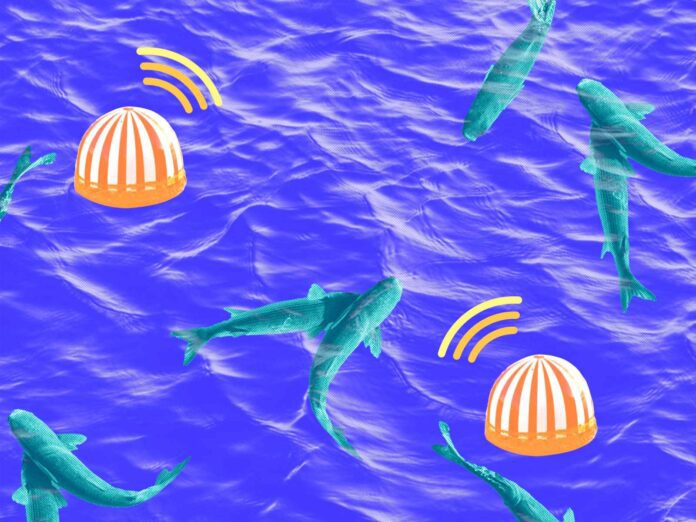Tech Mahindra launches a sports cloud platform built on AWS to provide an immersive fan experience globally
SOURCE: HTTPS://WWW.MAHINDRA.COM/
NOV 27, 2023
Underwater IoT: The Promise of Data Analytics in Aquaculture
SOURCE: IOTFORALL.COM
FEB 11, 2022

If you follow IoT, you know how much it’s changing industries. Devices collect data. Analytics platforms turn that data into insight, often with an AI component that enables powerful predictions. So you’ve got predictive maintenance eliminating unplanned downtime on production lines, smart automation cutting costs across the facility, supply chain visibility tracking shipments from production to the consumer’s door, and more. The optimizations are endless. Still, you might be wondering how IoT could affect something so complex as aquaculture.
What happens when your product is a living creature, swimming away in the briny deep? You may not think IoT is for you. As it turns out, IoT analytics has plenty to offer fish farmers and the animals they raise. Here’s the story of how today’s IoT systems are improving aquaculture, from the hatchery to your dinner plate—and how that relates to the industrial IoT you already know and love.
Successful plant farmers know the ideal nutrient levels for each stage of crop growth. They use measurements to adjust fertilizer, which optimizes soil productivity. With IoT analytics, fish farmers do the same. Think of it as preventive—sometimes even predictive—maintenance for the scale-and-fin set. IoT systems give aquaculture professionals the visibility they need to do the following:
That all sounds great, but it leaves one important question: How?
On average, it takes about two years to grow a salmon from egg to market. Plus, those years are not without risk. Farmers grow salmon in coastal pens, which is to say in the ocean. That’s a much less controlled environment than your average factory. Still, familiar IoT approaches can help create better processes and a richer harvest—just with more specialized devices and an eye on some unique data points.
Here’s the anatomy of an aquaculture IoT system (which does wonders for the anatomy of the fish):
Take our ocean salmon fishery as an example (but rest assured inland fish farms use similar IoT solutions). Buoys float in fish pens, dangling cables strung with sensors that measure environmental factors at various depths within the water column. Common measurements include:
Meanwhile, cameras and infrared sensors keep an eye on fish activity below the waves. While some sensors track environmental data, others collect information on the animals themselves, including:
These IoT cameras aren’t just collecting this data as an aggregate. The speckle patterns on a fish’s hide are as identifiable as your thumbprint. Software uses these patterns to recognize individual fish, tracking data as granular as the sand on the seafloor.
But all this data is useless without connectivity, which acts as the force that puts the “internet” in “internet of things.”
Many coastal fish farms are outside the range of cellular towers, so a lot of ocean-based IoT relies on satellite connections. Another exciting option is to use connected buoys, which can transmit data over radio frequencies to create a localized network.
Let us know what kinds of IoT, AI, and digital transformation content to share!
Technology Basics and Resources
Use Cases, Products, and Solutions
Technology Analyses & Deep-Dives
Top Industry News and Tech Trends
In the best-case scenario, these connections provide real-time data—but even near-real-time transmission allows farmers to respond to changing conditions much faster than a pencil and a clipboard, the traditional alternative.
Either way, all the IoT sensors discussed above send their readings to a server on the edge. Those servers classify the data. Then, they move it along as quickly as possible to the final stop in our tour of the aquaculture IoT system: the analytics platform.
Collecting data isn’t enough. To really optimize a process, you also need analytics—including AI models that combine disparate data points into a single accurate prediction. The best analytics software for aquaculture will do a few things at once. It will:
Platforms that can do all these things are available, but we left one important feature off our list: You want your aquaculture analytics system to provide end-to-end insights. That means it maintains data across the entire aquaculture lifecycle.
A farmed fish’s life begins at the hatchery, where farmers track the data points we’ve already discussed. Measurements are easier there; farmers are dealing with indoor tanks, not the open sea. But when mature fish move to the farm, the data visibility continues. Once they’ve reached the right size, the fish travel, alive, to the processing factory, where production machinery itself collects even more data. From there, fish products get packaged and shipped to market, sending updates along the way.
An ideal analytics solution tracks data at every one of these stages, providing full supply chain visibility. That way, if something goes wrong with a certain batch, the farmer can track down the exact source of the problem. If regulators ask for more compliance reporting, it’s just a few clicks away. And every shipment of sustainably grown fish is properly labeled, so consumers know they’re getting an authentic product. Visibility gives fish farmers control, even long after their product leaves its watery home.
That concept will be familiar to anyone who knows industrial IoT. The value of visibility is not unique to aquaculture, which is, after all, just another industry—one that’s getting better and better thanks to IoT innovations. In short, IoT and data analytics deliver serious business insights. Underwater or on dry ground, imagine what that could do for your operation.
LATEST NEWS
Augmented Reality
Hi-tech smart glasses connecting rural and remote aged care residents to clinicians
NOV 20, 2023
WHAT'S TRENDING


Data Science
5 Imaginative Data Science Projects That Can Make Your Portfolio Stand Out
OCT 05, 2022

SOURCE: HTTPS://WWW.MAHINDRA.COM/
NOV 27, 2023
SOURCE: HTTPS://WWW.IOTTECHNEWS.COM/
OCT 27, 2023
SOURCE: HTTPS://WWW.THEDAILYSTAR.NET/CAMPUS/
OCT 01, 2023
SOURCE: HTTPS://WWW.IOTFORALL.COM/
SEP 11, 2023
SOURCE: HTTPS://WWW.IOTTECHNEWS.COM/
AUG 10, 2023
SOURCE: HTTPS://WWW.SCIENCEDAILY.COM/
AUG 11, 2023